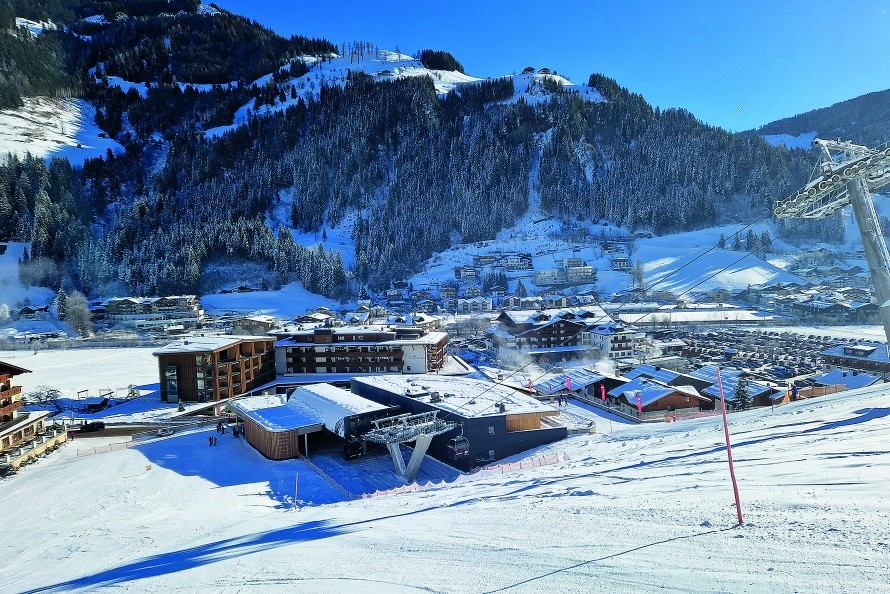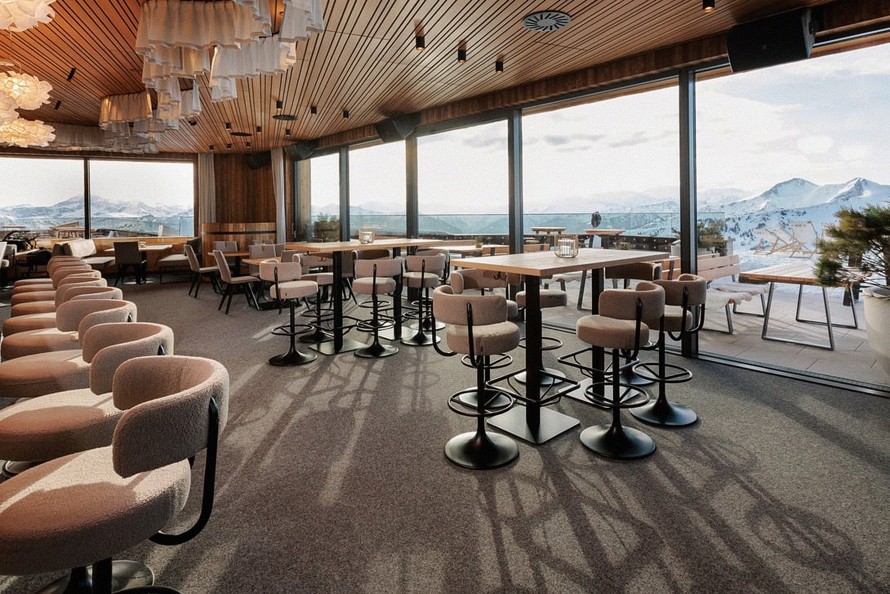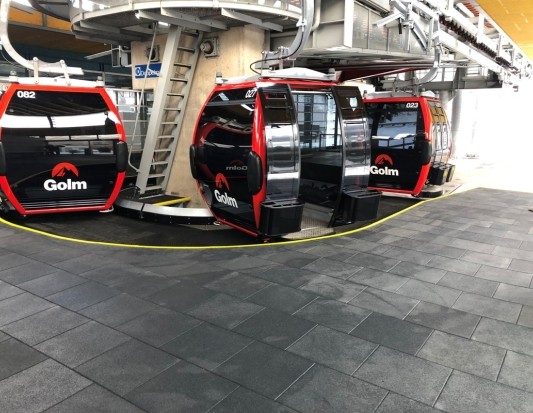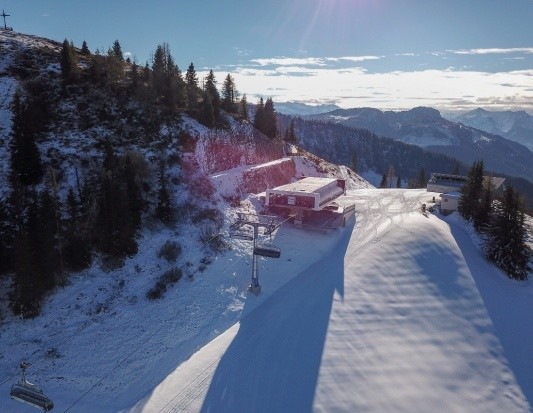Detachable 10-seater gondola monocable Kieserl
Großarl
Rediscovering the Magic of Kieserl: A Century-Old Ski Haven Reborn
A century after its first ascent and half a century since the last descent, the 1,954-metre-high Kieserl with the Roslehenalm is finally set to become a ski resort once more. The peak in the Großarl Valley has a storied history in alpine sports. Now, thanks to a grand project by Großarl Mountain Railways, this historic ski area has been reopened and now offers an enticing connection to Dorfgastein.
Salzmann Engineers have been on board with the cableway planning since 2015, and within roughly 18 months following the final decision, they completed one of Austria's most modern cableways. This journey was not without its challenges, both in terms of terrain and logistics, but it also saw the project grow to include an autonomous cableway system.
Starting Point
With abundant sunshine, designated slopes, and the chance to enhance the ski circuit, Kieserl holds great potential – a rare commodity in today’s winter tourism. Straddling the border between the Salzburg municipalities of Großarl and Dorfgastein, the mountain offers snow-covered pistes in winter and lush, managed pastures in summer. The ski areas have long been connected via the Kreuzkogel and Fulseck chairlifts and gondolas, but transitions were never seamless. The Kieserl and the Roslehenalm beneath it represented an untapped gem, poised for perfection.
Salzmann Engineers entered the scene in 2015, exploring numerous variants. Their team considered the sun’s path, projected guest movement, and examined routes. The existing 8-seater Hochbrand gondola, built in 2006, was always part of their considerations, running from Unterberg slightly past the Panoramabahn mid-station. However, the short but steep slope to the 6-seater chairlift was too challenging for many skiers, leading them to prefer the Panoramabahn to the top. The inconvenient placement of the summit station and the long walk from the car park to the gondola were also issues. The new Kieserlbahn promised not just a leap in quality and capacity but also the perfect chance to address these problems.
Instead of constructing a new section on the existing route and a second section up to Kieserl, Salzmann Engineers designed a state-of-the-art 10-seater gondola with two sections, ensuring a comfortable transfer. They managed the cableway technology and building requirements, handled approvals, and incorporated the autonomous AURO system during the project. Construction began in summer 2022, and by December 22, 2023, the gondola was carrying its first guests to Kieserl, some directly to the Sky Lounge “Wolke 7”.
Reopening the Original Ski Area
“This case is quite unique. Usually, we replace old facilities, adapt, or expand existing ones. With the Kieserlbahn, we got to reopen a ski area that had been unused for 50 years, with all the latest technology,” says Stephan Salzmann, CEO of Salzmann Engineers. While new areas are rarely approved and come with stringent requirements, the historically documented ski area allowed for quick and efficient implementation. The construction from Kieserl over the Roslehenalm down to the mid-station was done with minimal environmental impact. Mitigation measures like biotopes, dry stone walls, and the protection of forests and pasturelands were only necessary around the station buildings.
The project took nearly ten years from planning to the inaugural ride due to its scale. All possible options had to be thoroughly evaluated before breaking ground. “We developed around five different variants and assessed their feasibility with the authorities,” says Simon Stöckler, project manager at Salzmann Engineers. “The Kieserlbahn is a generational project. The investment is huge, and so is the responsibility. With the new gondola, we wanted to reflect the fantastic development of Großarl with its high-class hotels, restaurants, and guesthouses, and sustainably elevate our ski and hiking area,” emphasizes Peter Hettegger, hotelier and CEO of Großarl Mountain Railways.
The wait was worth it: since December 2023, up to 1,900 people per hour can ascend to the Großarl-Dorfgastein ski circuit with 70 kilometres of slopes and 17 lifts in just 15 minutes. “We are incredibly proud. The gondola is impressive and operates year-round, from morning until late evening. It's well-received by guests and locals alike,” Hettegger beams. Though winter sports are the focus, summer tourism is also growing in the alpine-rich Großarl Valley. Salzmann Engineers ensured the gondola was designed for year-round use: spacious, barrier-free, and low-maintenance for both winter and summer operations.
Comfortable and Autonomous: A Restart with Added Value
Initially, the Hochbrand gondola was part of the plan – at least the base station and the cableway itself. Until 2018, the facility was supposed to be used in a shortened form. However, practical considerations spoke against it: inconvenient access and nearly 20-year-old technology. The old summit station now serves as an equipment store, and the cableway will be repurposed in another ski area, while the base station was demolished. This created space for shorter access routes to car parks, an underground garage with 111 spaces, offices, a sports shop, a ski depot, staff housing, and the “Inferno” restaurant. Additionally, the new Kieserlbahn features the noise-optimized Performa cable, benefiting the local community.
The new construction also paved the way for the autonomous cableway system AURO (Autonomous Ropeway Operation) by Doppelmayr and Frey Austria. The unmanned operation with unstaffed base and summit stations and a central “Ropeway Operation Center” (ROC) at the mid-station required specific structural adjustments and couldn't be based on older technology. This idea was introduced late in the project, recalls Simon Stöckler: “We realized an autonomous pioneering project with the Valisera gondola in the Silvretta Montafon ski area in 2022. When the desire for this innovative solution arose in Großarl, it was almost too late.”
Where there's a will, there's a way. Stations, vehicles, and operations were re-conceived during ongoing construction without altering the timeline. Salzmann Engineers and their partners worked tirelessly to integrate the system and secure project approvals. “We revamped the passenger areas, building technology, and operations completely. Where no personnel are involved, a monitored access system ensures, for example, that no one boards in adverse weather. Our experience was invaluable,” Stöckler recounts. The construction permit from August 2022 was amended in May 2023, including an additional level at the summit with a sun terrace and an extra underground garage level at the base.
Movable Terrain
The new mid-station is about 200 meters below the Hochbrand mountain station, level with the mid-station of the Panoramabahn. Thus, guests can now easily move from one place to another. Of course, there's a small catch. The slope around the new building is sliding – in some places by up to four meters over the next 40 years. These forecasts resulted from geological measurements and complex calculations. The moving terrain naturally affects the cable car. "We had to find the right positions for the supports and create movable foundations," explains Stöckler. To ensure the lift stays on track despite slope movements, 9 of the 23 supports can be moved along rails.
The building itself stands on solid ground – and yet will move slightly. Steel-reinforced concrete columns secure the station at the most stable points. This leads to a curious situation: a hand's breadth of space was left around the columns to accommodate the expected movement of the structure. The special geological situation required another calculation – this time regarding fire protection. Just above the station are the Zapfenbar and Alpentaverne buildings. Where their roofs will be in 40 years and how close they will be to the cable car was the subject of complex calculations and influenced the routing.
Across the Ravine
One small hurdle remained at the very end: the Harbachgraben ravine cuts through the path from the summit of the Kieserl down to the mid-station. "A ski crossing in the form of a piste was not approvable. We had to find another way to cross the ravine. A conveyor belt was not feasible, so we opted for a rope tow," reports Simon Stöckler. The collaboration between Großarl and Salzmann Ingenieure continues. In the coming years, a new 6-seater chairlift, the Roslehenalmbahn, will follow.
Anlagedaten
- Antrieb
- Mountain station
- Antrieb und Spannung
- Middle station
- Antriebsleistung Anfahren
- 747 kW
- Antriebsleistung Betrieb
- 620 kW
- Anzahl Stützen
- 23
- Bahnsystem
- Detachable 10-seater gondola monocable
- Fahrgeschwindigkeit
- 6,5 m/s
- Fahrstrecke gesamt
- 2.410 m
- Fahrzeit
- 15 minutes (section I + II)
- Förderleistung
- AB 800 / EB 1900
- Anzahl Fahrzeuge
- 46
- Kabinenanzahl
- 46
- Ropeway technology manufacturer
- Doppelmayr
- Electrical technology manufacturer
- Frey Austria























